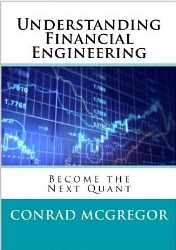Positive might make it sound like a good thing, but positive feedback loops in the markets cause death spirals. In the crisis of 2008 and the flash crash of 2010, high frequency trading was blamed as reason for market volatility. In a way that is true, when high frequency trading computers sense massively dislocating markets they often shut off to stop their algorithms from losing too much money. All of a sudden these electronic liquidity providers disappear and the market gaps around. On the flip side, how is that different than the trading that occurred on October 19, 1987? If you experienced or read about that day you would realize that the same thing happened, except instead of computers stepping away from the market it was the human market makers.
What I believe is common between these volatile periods is what can be called the positive feedback loop. The positive feedback loop can be triggered by the act of rebalancing a hedge. For insurance companies, mortgage providers, investment banks, and any other institutions sourcing embedded guarantees, a move in the financial markets causes these institutions to rebalance their positions primarily by using derivatives. In the simple case of 1987, we blame the market spiral on “portfolio insurance” or put options that were placed on institutional and retail client portfolios. These put options simply guaranteed that the client would not lose more than X%. As markets tumbled, the institutions that offered the guarantee were required to sell more and more equities to protect the client’s assets. When the market goes down, sell more. When the market goes up, buy more. A positive feedback loop.
This dynamic now occurs daily and in significant size by the largest financial institutions on the planet. In addition, the larger the move in the markets the larger the required re-balancing hedge trades. When looking at one company, this risk seems small, but when adding up all of these institutions hedging similar risks these trades become massive. On top of these hedge trades, when the markets move negatively we find that both retail and institutional traders get scared. They want to protect their assets so they often sell, which just creates further downward pressure on prices (upward on bonds). This is a positive feedback loop.
I believe that this dynamic has been missed by most market participants and commentators. It is often stated that credit default swaps, the notional size of the derivatives markets, the trading of hedge funds, or the trading of black boxes have caused market volatility. I think that market volatility has been created by easy monetary policy and the financial bubbles that were created as a consequence. Market volatility was amplified by the positive feedback loop of modern financial trading.
A Demon of Our Own Design: Markets, Hedge Funds, and the Perils of Financial Innovation
Inside markets, innovation, and risk
Why do markets keep crashing and why are financial crises greater than ever before? As the risk manager to some of the leading firms on Wall Street–from Morgan Stanley to Salomon and Citigroup–and a member of some of the world’s largest hedge funds, from Moore Capital to Ziff Brothers and FrontPoint Partners, Rick Bookstaber has seen the ghost inside the machine and vividly shows us a world that is even riskier than we think. The very things done to make markets safer, have, in fact, created a world that is far more dangerous. From the 1987 crash to Citigroup closing the Salomon Arb unit, from staggering losses at UBS to the demise of Long-Term Capital Management, Bookstaber gives readers a front row seat to the management decisions made by some of the most powerful financial figures in the world that led to catastrophe, and describes the impact of his own activities on markets and market crashes. Much of the innovation of the last 30 years has wreaked havoc on the markets and cost trillions of dollars. A Demon of Our Own Design tells the story of man’s attempt to manage market risk and what it has wrought. In the process of showing what we have done, Bookstaber shines a light on what the future holds for a world where capital and power have moved from Wall Street institutions to elite and highly leveraged hedge funds.Inside markets, innovation, and risk
Why do markets keep crashing and why are financial crises greater than ever before? As the risk manager to some of the leading firms on Wall Street–from Morgan Stanley to Salomon and Citigroup–and a member of some of the world’s largest hedge funds, from Moore Capital to Ziff Brothers and FrontPoint Partners, Rick Bookstaber has seen the ghost inside the machine and vividly shows us a world that is even riskier than we think. The very things done to make markets safer, have, in fact, created a world that is far more dangerous. From the 1987 crash to Citigroup closing the Salomon Arb unit, from staggering losses at UBS to the demise of Long-Term Capital Management, Bookstaber gives readers a front row seat to the management decisions made by some of the most powerful financial figures in the world that led to catastrophe, and describes the impact of his own activities on markets and market crashes. Much of the innovation of the last 30 years has wreaked havoc on the markets and cost trillions of dollars. A Demon of Our Own Design tells the story of man’s attempt to manage market risk and what it has wrought. In the process of showing what we have done, Bookstaber shines a light on what the future holds for a world where capital and power have moved from Wall Street institutions to elite and highly leveraged hedge funds.




